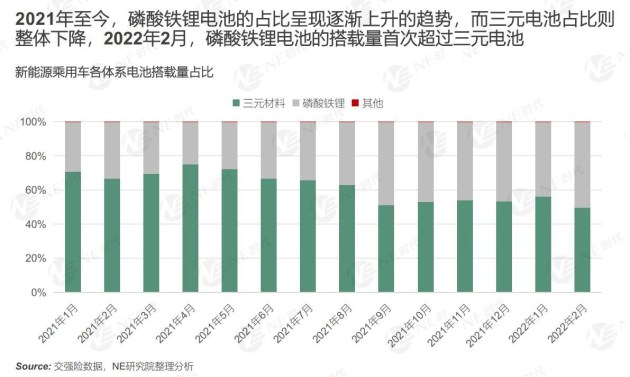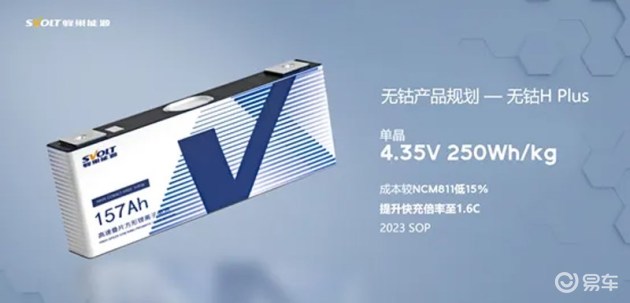
Affected by factors such as the epidemic and the international situation, the prices of power battery raw materials such as lithium and nickel continue to rise, as well as supply chain interruptions, etc., resulting in domestic new energy vehicle prices rising by 2 since the end of last year. -3 rounds, which directly increases the cost of consumers’ car purchases. This is not good news for both supply and demand sides. If the increase is small, some consumers may still be able to accept it, but if the increase is too large and consumers cannot afford it, it may directly affect the decision to purchase new energy vehicles, thereby affecting the overall development of the new energy market.
To solve the problem of soaring prices of new energy vehicles, we must first solve the floating price of power battery raw materials. However, from the current point of view, this market supply and demand is difficult to change in a short time. In the long term, the solution The best way to solve this problem is to persist in the diversified development of battery technology and materials and get rid of the current constraints of raw materials such as lithium.
Recently, Lin Nianxiu, deputy director of the National Development and Reform Commission, proposed at the China Electric Vehicle 100 Forum that we should consolidate the technological and industrial advantages of lithium-ion batteries and accelerate the development of new batteries such as sodium-ion, cobalt-free, solid-state batteries, and fuel cells. technology, promote the diversification of battery technology and materials, and encourage Chinese and foreign enterprises to innovate cooperation models to effectively alleviate the supply contradiction of rare metals and scarce metal resources.
Zeng Yuqun, chairman of CATL, also believes that "carbon neutrality" has given rise to trillions of watt-hour battery demand and promoted the vigorous development of the new energy industry. New application scenarios are constantly emerging, giving different technologies The stage for performance. Diversified technical routes will also help the long-term stable development of the industry.


In fact, the power batteries used by new energy models in the current market are basically composed of lithium iron phosphate and ternary batteries. In the first two months of this year, my country's power battery installed capacity accumulated to 29.9GWh, a year-on-year increase of 109.7%. Among them, the cumulative installed volume of ternary batteries is 13.1GWh, accounting for 43.8% of the total installed volume, a cumulative year-on-year increase of 50.6%; the cumulative installed volume of lithium iron phosphate batteries is 16.7GWh, accounting for 55.9% of the total installed volume, a cumulative year-on-year increase of 203.1%, showing Rapid growth and development momentum. It is worth noting that the installed volume of lithium iron phosphate batteries exceeded that of ternary batteries for the first time in February.
In addition to the above two mainstream batteries, sodium-ion batteries, cobalt-free batteries, solid-state batteries and fuel cells have also been developed.
On July 29 last year, CATL released its first-generation sodium-ion battery. At the same time, the lithium-sodium hybrid battery pack also made its debut at the press conference. This is based on the "double carbon" economy and the new energy industry entering a multi-level, multi-type, and diversified development stage, and the new energy vehicle market has put forward differentiated demands for batteries.
Sodium-ion batteries have a similar working principle to lithium-ion batteries. Charge transfer is mainly achieved through the insertion and extraction of sodium ions between the positive and negative electrodes. However, the sodium ions are larger in size and have problems with the stability of the material structure. The requirements for chemical and kinetic performance are more stringent, which has also become a bottleneck that has made it difficult for sodium-ion batteries to be commercialized.

Based on material system breakthroughs, the first-generation sodium-ion battery developed by CATL has high energy density, high-rate charging, excellent thermal stability, good low-temperature performance and high integration efficiency and other advantages. The energy density of its single cell is as high as 160Wh/kg (according to CATL’s plan, the research and development target for the energy density of the next-generation sodium-ion battery is more than 200Wh/kg); after charging for 15 minutes at room temperature, the power can reach more than 80%; at -20 It also has a discharge retention rate of more than 90% in a low temperature environment of °C; the system integration efficiency can reach more than 80%; and the thermal stability far exceeds national safety standards.
In terms of manufacturing technology, sodium-ion batteries can be perfectly compatible with lithium-ion battery production equipment and processes. The production line can be quickly switched to complete the rapid layout of production capacity. At present, CATL has launched the industrialization layout of sodium-ion batteries, and a basic industrial chain will be formed in 2023.
The cost of lithium iron phosphate batteries currently used in the industry is low, but on the other hand the energy density is usually 170-180Wh/kg; while the energy density of the ternary system can reach up to 250wh/kg, but Cobalt is used in ternary materials. Due to reserves and mining volume, the international market price of cobalt is extremely unstable and has remained high for a long time.

The cobalt-free technical route is mainly to balance users’ balanced pursuit of long battery life, high safety, high fast charging, and low cost. It is based on the ternary system The cobalt-free route derived from NMX, cobalt-free materials can achieve product design of high energy density battery cells.
It is understood that Honeycomb Energy’s cobalt-free materials have achieved zero cobalt element, thus being completely unaffected by the cobalt market and achieving low cost. At the same time, their energy density can be the same as that of ternary materials. Therefore, in the long run, cobalt-free batteries have huge competitive advantages compared with lithium iron phosphate technology and ternary battery technology, and are an irreplaceable trend in industry development.
Battery products made from the cobalt-free cathode material of Honeycomb Energy H platform can have a cycle life of more than 2,500 times at room temperature. In terms of energy density, cobalt-free batteries can currently achieve 240~245Wh/kg, which is much higher than the 170~180Wh/kg level of mainstream lithium iron phosphate batteries, and also very close to the 240~250Wh/kg level of 811 system ternary lithium batteries.
It is worth mentioning that the Euler Cherry Cat equipped with Honeycomb Energy's cobalt-free lithium-ion battery was unveiled at the Chengdu Auto Show last year. It uses an 82.5kWh cobalt-free battery pack with an NEDC range of 600km. This is also the world's first new energy vehicle equipped with a cobalt-free battery and is expected to be launched within this year.
It should be noted that Panasonic President Yuuki Kusumi recently stated that Panasonic will strive to achieve mass production of cobalt-free batteries within three years. This means that there is a certain market demand for cobalt-free batteries, but it will take time to test whether they will be installed in large quantities.

Solid state electricityBatteries are batteries that use solids as the electrolyte and conductive medium. This kind of battery has huge differences in raw materials and production paths from the currently commonly used liquid electrolyte batteries. Solid-state batteries can be divided into semi-solid, quasi-solid and all-solid-state batteries according to the degree of curing.
Ouyang Minggao, vice chairman of the China Electric Vehicles Association of 100 and academician of the Chinese Academy of Sciences, said that 2025 is a critical period for the transition from liquid batteries to solid-state batteries. The goal of my country's power battery industrialization is that by 2025, Liquid system battery cell energy The density will reach 350Wh/kg; in 2030, the energy density of solid-liquid hybrid system battery cells that transition from liquid batteries to solid-state batteries will be 400Wh/kg; in 2035, the energy density of quasi/all-solid-state system battery cells will reach 500Wh/kg. In 2030, it is expected that the proportion of domestic all-solid-state batteries will not exceed 1%.
From the current point of view, solid-state batteries are only developing in the semi-solid-state battery stage, and the first one to be installed in cars is NIO ET7. According to recently exposed news, NIO ET7 uses a hybrid solid-liquid electrolyte battery provided by Weilan New Energy with a single charge range of 1,000km. Mass production of the battery is expected to begin at the end of this year or in the first half of next year.
In terms of energy density, solid-state batteries can reduce volume by 40% and weight by 25% through chemical composition. Taking CATL's solid-state battery patented technology as an example, it is expected to eventually break through the energy density of 500Wh/kg.
In terms of safety, solid-state batteries are non-flammable, non-volatile, non-corrosive and non-leakable compared to current liquid electrolyte batteries, and no side reactions will occur even in high-temperature environments. . In addition, solid-state batteries have stronger temperature adaptability in structure and have a longer service life than liquid batteries.
Theoretically, solid-state batteries can solve most of the troublesome problems of current liquid electrolyte batteries, but there are still certain difficulties in mass production and commercialization.

On March 23, the National Development and Reform Commission and the National Energy Administration jointly issued the "Mid- and Long-term Plan for the Development of Hydrogen Energy Industry (2021-2035)", which proposed support Hydrogen fuel cell technology is developing, and it is planned that by 2025, the number of fuel cell vehicles will be approximately 50,000. In addition, the plan also clarified for the first time that hydrogen energy is an important part of the future national energy system, and hydrogen production from renewable energy is the main development direction.
Japanese and Korean car companies have been in the field of hydrogen fuel cells for a long time, and their products are relatively more mature. Domestically, SAIC Motor invested earlier in the FCEV field, investing in Hydrogen Jet Technology, which specializes in the research and development of hydrogen fuel cell systems. SAIC Maxus also released the fuel cell MPV—EUNIQ 7.
Written at the end: From the current stage, the best way to solve the problem of rising new energy vehicle prices is to ensure supply and stabilize prices, strengthen the construction of resource security systems such as lithium, nickel, and cobalt, and accelerate the construction of Development and procurement are simultaneously promoted, and a diversified supply guarantee system with domestic and international mutual assistance maintains market supply and demand.In the long term, continuous breakthroughs in battery technology are needed to find raw materials that better meet market demand.